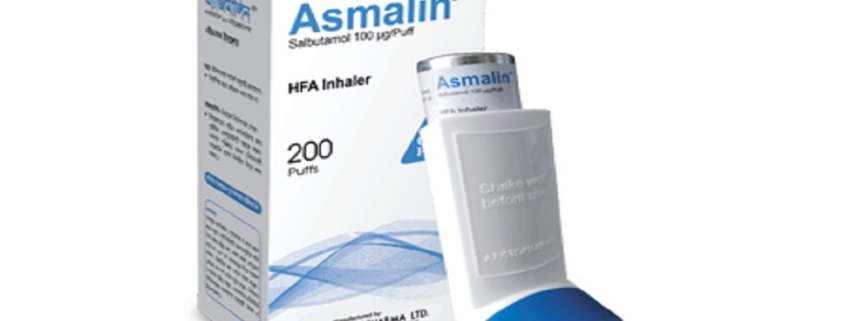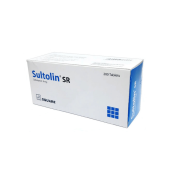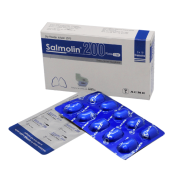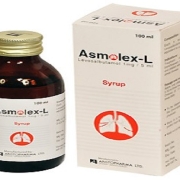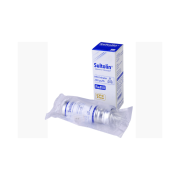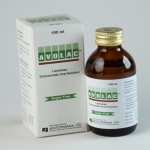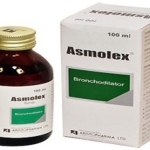Asmalin® HFA Inhaler (Salbutamol)
Description
Salbutamol is a selective beta2-adrenoceptor agonist. At therapeutic doses, it acts on the beta2-adrenoceptors of bronchial smooth muscle, with little or no action on the ß1 adrenoceptors of cardiac muscle. Salbutamol provides short acting (4-6 hours) bronchodilatation with a fast onset (within 5 minutes) in reversible airways obstruction. It also has an anti-inflammatory effect on mast cells causing inhibition of release of bronchoconstrictor mediators including histamine, neutrophil chemotactive factor (NCF) and prostaglandin D2.

Presentation
Asmalin® HFA Inhaler: Each puff delivers Salbutamol Sulphate BP equivalent to Salbutamol 100 µg.
Indications
- Bronchospasm
Asmalin® HFA Inhaler is indicated for the treatment or prevention of bronchospasm in bronchial asthma and for the treatment of reversible airways obstruction associated with bronchitis and emphysema.
- Exercise-Induced Bronchospasm
Asmalin® HFA Inhaler may be used to relieve attacks of acute dyspnoea and may also be taken prophylactically before exertion or to prevent exercise-induced Bronchospasm.
Dosage & Administration
Administer Asmalin® HFA Inhaler by oral inhalation only. ShakeAsmalin® HFA Inhaler well before each spray.
For relief of acute episodes of bronchospasm:
Adults: 1 or 2 puffs as necessary. The maximum dose is up to 8 puffs in 24 hours.
Children: Half the adult dose.
To prevent allergen- or exercise-induced bronchospasm:
Adults: 2 puffs 15 minutes prior to exercise or exposure to allergen.
The maximum dose is 2 puffs, up to 4 times a day. Children: Half the adult dose.
Chronic therapy:
Adults: Up to 200 µg (2 puffs) four times daily
Children: Up to 200 µg (2 puffs) four times daily
Contrainidications
Asmalin® HFA Inhaleris contraindicated in patients with a history of hypersensitivity to salbutamol or any other components.
Warning & Precautions
Paradoxical Bronchospasm
Inhaled salbutamol sulfate can produce paradoxical bronchospasm, which may be life threatening. If paradoxical bronchospasm occurs, Asmalin® HFA Inhalershould be discontinued immediately and alternative therapy instituted. It should be recognized that paradoxical bronchospasm, when associated with inhaled formulations, frequently occurs with the first use of a new canister.
Cardiovascular Effects
Asmalin® HFA Inhaler,like all other beta2-adrenergic agonists, can produce clinically significant cardiovascular effects in some patients such as changes in pulse rate or blood pressure. If such effects occur, Asmalin® HFA Inhalermay need to be discontinued. In addition, beta-agonists have been reported to produce electrocardiogram (ECG) changes, such as flattening of the T wave, prolongation of the QTc interval, and ST segment depression. The clinical relevance of these findings is unknown. Therefore, Asmalin® HFA Inhaler, like all other sympathomimetic amines, should be used with caution in patients with underlying cardiovascular disorders, especially coronary insufficiency, cardiac arrhythmias, and hypertension.
Immediate Hypersensitivity Reactions
Immediate hypersensitivity reactions may occur after administration of salbutamol sulfate inhalation aerosol, as demonstrated by cases of urticaria, angioedema, rash, bronchospasm, anaphylaxis, and oropharyngeal edema. Discontinue Asmalin® HFA Inhaler if immediate hypersensitivity reactions occur.
Coexisting Conditions
Asmalin® HFA Inhaler, like other sympathomimetic amines, should be used with caution in patients with convulsive disorders, hyperthyroidism, or diabetes mellitus and in patients who are unusually responsive to sympathomimetic amines. Large doses of intravenous salbutamol have been reported to aggravate preexisting diabetes mellitus and ketoacidosis.
Side effects
Salbutamol is generally well tolerated. Few side effects have been observed during inhalation. There are tremor, anxiety, muscle cramps, headache, palpitation, a compensatory small increase in heart rate, cardiac arrhythmias (including atrial fibrillation, supraventricular tachycardia and extrasystoles), tachycardia may occur in some patients. Mouth and throat irritation may occur with inhaled salbutamol.
Drug interaction
Salbutamol and non-selective beta-blocking drugs such as propranolol should generally not be prescribed together. Potentially serious hypokalaemia may result from beta2-agonist therapy. Particular caution is advised in acute severe asthma as this effect may be potentiated by concomitant treatment with xanthine derivatives, steroids, diuretics, and by hypoxia. It is recommended that serum potassium levels are monitored in such situations.
Use in special groups
Use in pregnancy:
Pregnancy Category C. There are no adequate and well-controlled studies of Asmalin® HFA Inhaler or salbutamol sulfate in pregnant women. Asmalin® HFA Inhalershould be used during pregnancy only if the potential benefit justifies the potential risk to the fetus.
Use in lactation:
Itis not known whether the components of Asmalin® HFA Inhalerare excreted in human milk. Caution should be exercised when Asmalin® HFA Inhaleris administered to a nursing woman.
Use in children:
The safety and effectiveness of Asmalin® HFA Inhalerin children 4 years of age and older have been established.
Packing
Asmalin HFA inhaler: Each canister contains 200 puffs.

